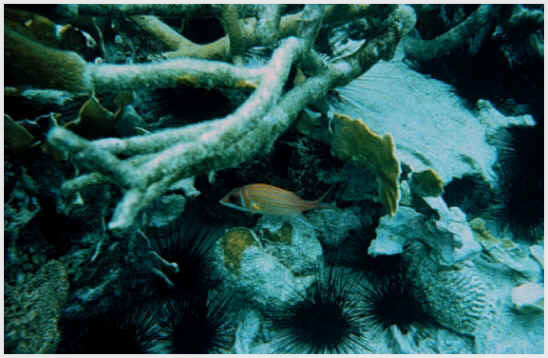
In 1983, a mass mortality of the sea urchin Diadema antillarum reduced the density of this common Caribbean echinoid by two orders of magnitude. I have been pursuing a long-term investigation of the population dynamics of Diadema, changes in the benthic community structure following the mass mortality, and the consequences of the mortality event for co-occurring species of sea urchins. This work has involved laboratory studies, field experiments, large-scale geographic surveys, and examination of museum specimens in an attempt to document the present and historic effects of population fluctuations in this important Caribbean species. These population fluctuations, which have a profound impact on Caribbean reefs, may partially be driven by human activity.
Relevant Publications:
2014 Edmunds, P.J., X. Ponchon, D.R. Levitan, D.M. Yost, M. Belcaid, H. M. Putnam, R.D. Gates. Long-term changes in Symbiodinium communities in Orbicella annularis in St. John, U.S. Virgin Islands. Marine Ecology Progress Series 506:129-144 [PDF].
2014 Levitan, D.R., P.J. Edmunds, K.E. Levitan. What makes a species common? No evidence of density-dependent recruitment or mortality of the sea urchin Diadema antillarum after the 1983–84 mass mortality. Oecologia 175:117-128 [PDF].
2005 Levitan, D.R. and T.M. McGovern. The Allee effect in the Sea. Pages 47-57 in (E.A. Norse and L.B. Crowder eds) Marine Conservation Biology: The Science of Maintaining the Sea’s Biodiversity. Island Press
2001 Petersen, C. and D.R. Levitan. The Allee effect: a barrier to repopulation of exploited species. Pages 281-300 in (J.D. Reynolds, G.M. Mace, K.H. Redford and J.G. Robinson eds.) Conservation of Exploited Species. Cambridge University Press.
1992 Levitan, D.R. Community structure in times past: influence of human fishing pressure on algal-urchin interactions. Ecology 73:1597-1605. [PDF]
1991 Levitan, D.R. Skeletal changes in the test and jaws of the sea urchin Diadema antillarum when food-limited. Marine Biology 106:431-435. [PDF]
1991 Levitan, D.R. Influence of body size and population density on fertilization success and reproductive output in a free-spawning invertebrate. Biological Bulletin 181:261-268. [PDF]
1990 Karlson, R.H. and D.R. Levitan. Recruitment-limitation in open populations of Diadema antillarum: an evaluation. Oecologia 82:40-44. [PDF]
1989 Levitan, D.R. Density‑dependent size regulation in Diadema antillarum: effects on fecundity and survivorship. Ecology 70:1414-1424. [PDF]
1989 Levitan, D.R. and S.J. Genovese. Substratum dependent predator-prey dynamics: Patch reefs as refuges from gastropod predation. Journal of Experimental Marine Biology and Ecology 130:111-118. [PDF]
1988 Levitan, D.R. Asynchronous spawning and aggregative behavior in the sea urchin Diadema antillarum Philippi. In (R.D. Burke et al. eds.) Echinoderm Biology, pp 181-186, A.A. Balkema Press, Rotterdam. [PDF]
1988 Levitan, D.R. Algal urchin biomass responses following the mass mortality of the sea urchin Diadema antillarum Philippi at Saint John, U.S. Virgin Islands. Journal of Experimental Marine Biology and Ecology 119:167-178. [PDF]
1988 Levitan, D.R. Density‑dependent size regulation and negative growth in the sea urchin Diadema antillarum Philippi. Oecologia 76:627-629. [PDF]